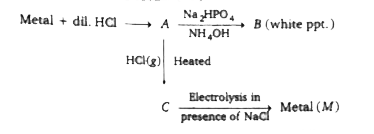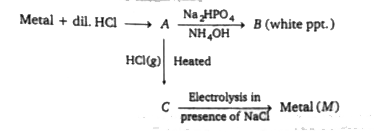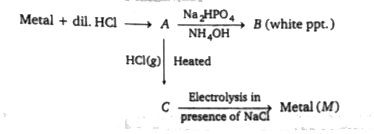Complete Solutions to Level 3 of chapter s-BLOCK ELEMENTS of Class 12 book with complete answers and questions
| Class 12 | CHEMISTRY |
| Chapter | s-BLOCK ELEMENTS |
| VK JAISWAL | Level 3 |
| Number Of Questions | 50 |
| Academic Year | 2023-24 |
Dilute solutions of alkali metals in liquid `NH_(3)` are blue. It is the ammoniated electron which is responsible for the blue colour of the solution, and the electrical conductivity is due to the ammoniated cation, `[M(NH_(3))_(x)]^(+)` as well as the ammoniated electrons, `[e(NH_(3))_(y)]^(-)`, values of x and y depend on the extent of solvation (by `NH_(3)`). Dilute solutions are paramagnetic due to free electrons.
What happens if alkali metals is allowed to react with concentrated liquid ammonia?
View SolutionAll alkali metals dissolve in anhydrous liquid ammonia to give blue colour solution. It is the ammoniated electron which is reponsible for the blue colour of the solution, and the electrical conductivity is due to the ammoniated cation, `[M(NH_(3))_(x)]^(+)` as well as the ammoniated electron,` [e(NH_(3))_(y)]^(-)`, value of x and y depend on the extent of solvation by `NH_(3)`. Dilute solutions are paramagnetic due to free ammoniated electrons.
Q. Which of the following statement about solution of alkali metals in liquid ammonia is correct?
View SolutionAll alkali metals dissolve in anhydrous liquid ammonia to give blue colour solution. It is the ammoniated electron which is reponsible for the blue colour of the solution, and the electrical conductivity is due to the ammoniated cation, `[M(NH_(3))_(x)]^(+)` as well as the ammoniated electron,` [e(NH_(3))_(y)]^(-)`, value of x and y depend on the extent of solvation by `NH_(3)`. Dilute solutions are paramagnetic due to free ammoniated electrons.
Q. Ammoniated solutions of alkali metals are reducing agents due to the presence of free ammoniated or solvated electrons that can reduce:
(I)`O_(2) "to" O_(2)^(2-)` (II) `K_(2)[Ni(CN)_(4)] " to "K_(4)[Ni(CN)_(4)]`
(III) Aromatic ring (IV) Non-terminal alkyne
Choose the correct code:
View Solution`Naoverset(H_(2)O)(to)Aoverset(CO_(2))(to)Boverset(SO_(2))(to)Coverset(Na_(2)S"/"I_(2))underset(delta)(to)Doverset(Ag^(+)"/"Salt)(to)E`(complex)
Q. The compounds B and C is
View Solution`Naoverset(H_(2)O)(to)Aoverset(CO_(2))(to)Boverset(SO_(2))(to)Coverset(Na_(2)S"/"I_(2))underset(delta)(to)Doverset(Ag^(+)"/"Salt)(to)E`(complex)
Q. The compound D is
View Solution`Naoverset(H_(2)O)(to)Aoverset(CO_(2))(to)Boverset(SO_(2))(to)Coverset(Na_(2)S"/"I_(2))underset(delta)(to)Doverset(Ag^(+)"/"Salt")(to)E`(complex)
Q. Oxidation number of each 'S' atom in compound D:
View Solution
Q. The compound A is :
View Solution
Q. The compound B is :
View Solution
Q. The compound C and metal M are:
View SolutionCalcium sulphate is found in nature in two forms, anhydrous calcium sulphate and hydrated calcium sulphate. When anhydrous calcium sulphate is heated with coke, sulphur dioxide gas is obtained. When hydrated calcium suphate is heated to `200^(@)`C, it forms anhydrous salt.
Q. The anhydrous calcium sulphate is called :
View SolutionMix calcium sulphate with conc. HCl and forms a paste. Bring a pinch of this paste near to the flame, what colour will you obtain?
View SolutionCalcium sulphate is found in nature in two forms, anhydrous calcium sulphate and hydrated calcium sulphate. When anhydrous calcium sulphate is heated with coke, sulphur dioxide gas is obtained. When hydrated calcium suphate is heated to `200^(@)`C, it forms anhydrous salt.
Q. What is the product formed when hydrated `CaSO_(4)` is heated to `125^(@)`C instead of `200^(@)C`?
View SolutionSodium sulphite `(Na_(2)SO_(3))` is added to meat as a preservative. The presence of `Na_(2)SO_(4)` can be detected by adding dil. `H_(2)SO_(4)` when the pungent smelling gas evolved turns the lime water milky. The gas evolved was detected as sulphur dioxide. The `SO_(2) " to "SO_(4)^(2-)` in titration.
`SO_(2)+2H_(2)O+I_(2) to 4H^(+)+SO_(4)^(2-)+2I^(-)`
In order to check the results of titration, excess barium chloride is added to the final solution. The resulting precipitate is collected and weighed.
Q. `SO_(2) and CO_(2)` both lime water milky. Which of the following reagent can be used to distinguish these two gases?
(I)`K_(2)Cr_(2)O_(7)"/"H_(2)SO_(4)` (II)`KMnO_(4)"/"H^(+)` (III)`I_(2)` solution
View SolutionSodium sulphite `(Na_(2)SO_(3))` is added to meat as a preservative. The presence of `Na_(2)SO_(3)` can be detected by adding dil. `H_(2)SO_(4)` when the pungent smelling gas evolved turns the lime water milky. The gas evolved was detected as sulphur dioxide. The `SO_(2) " to "SO_(4)^(2-)` in titration.
`SO_(2)+2H_(2)O+I_(2) to 4H^(+)+SO_(4)^(2-)+2I^(-)`
In order to check the results of titration, excess barium chloride is added to the final solution. The resulting precipitate is collected and weighed.
Q. `SO_(2)` gas is used as bleaching agent. Its bleaching action is :
View SolutionSodium sulphite `(Na_(2)SO_(3))` is added to meat as a preservative. The presence of `Na_(2)SO_(4)` can be detected by adding dil. `H_(2)SO_(4)` when the pungent smelling gas evolved turns the lime water milky. The gas evolved was detected as sulphur dioxide. The `SO_(2) " to "SO_(4)^(2-)` in titration.
`SO_(2)+2H_(2)O+I_(2) to 4H^(+)+SO_(4)^(2-)+2I^(-)`
In order to check the results of titration, excess barium chloride is added to the final solution. The resulting precipitate is collected and weighed.
Q. Which of the following compounds is formed, when `Na_(2)SO_(3)` is boiled with sulphur.
View SolutionOn treatment with cold wate, element (A) reacted quietly, librating colourless gas (B) and solution ( C). Lithium reacted with gas (B) and giving a solid product (D) which gave effervesence with water to give basic solution (F). When `CO_(2)` was passed thorough solution ( C), an initial whit ppt (E) was formed but this redissolved forming solution (G) when more `CO_(2)` was passed. PPT (E) effervessced when moistened to Bunsen flame. (E ) on heating wiht excess of carbon at `2000^(@)C` gave (H):
Metal A may be:
View SolutionOn treatment with cold water, an element (A) reacts readily liberating a colourless, odourless gas (B) and a solution (C). Lithium is reacted with (B) yeildng a solid product (D) which effervesce with water to give a strongely basic solution (E). When `CO_(2)` gas is bubbled through solution (C), a white ppt. (F) is formed but this redissolved forming solution (G) when more `CO_(2)` is passed. Precipitate (F) effervesced when moistened with conc. HCl and give deep red colouration to Bunsen burner flame. (F) on heating with excess of carbon at `2000^(@)`C give (H).
Answer the following question on the basis of above passage.
Q. Solution (G) contains a salt which
(i) causes permanent hardness of water
(ii)can not be obtained in solid state
(iii)causes temporary hardness of water
(iv)can be obtained in solid state
Select the correct statements :
View SolutionOn treatment with cold water, an element (A) reacts readily liberating a colourless, odourless gas (B) and a solution (C). Lithium is reacted with (B) yeildng a solid product (D) which effervesce with water to give a strongely basic solution (E). When `CO_(2)` gas is bubbled through solution (C), a white ppt. (F) is formed but this redissolved forming solution (G) when more `CO_(2)` is passed. Precipitate (F) effervesced when moistened with conc. HCl and give deep red colouration to Bunsen burner flame. (F) on heating with excess of carbon at `2000^(@)`C give (H).
Answer the following question on the basis of above passage.
Q. Solid (H) on hydrolysis gives a gas which on passing through ammoniated `AgNO_(3)` solution yields:
View SolutionLithium only forms monoxide when heated in oxygen. Sodium forms monoxide and peroxide in excess of oxygen. Other alkali metals form superoxide metals superoxide with oxygen i.e., `MO_(2)`. The abnormal behaviour of lithium is due to small size. The larger size of higher metals also decides the role in formation of superoxide. All the three anions abstract proton from water. The three anions are raleted to each other as follows:
`underset("oxide ion")(O_(2)^(2-)overset((1)/(2)O_(2))(to)underset("peroxide ion")(O_(2)^(2-))overset(O_(2))(to)underset("superoxide ion")(2O_(2)^(-))`
Q. Consider the following reaction :
`M+O_(2) to MO_(2)`
(M=alkali metal) (stable superoxide)
View SolutionLithium only forms monoxide when heated in oxygen. Sodium forms monoxide and peroxide in excess of oxygen. Other alkali metals form superoxide metals superoxide with oxygen i.e., `MO_(2)`. The abnormal behaviour of lithium is due to small size. The larger size of higher metals also decides the role in formation of superoxide. All the three anions abstract proton from water. The three anions are raleted to each other as follows:
`underset("oxide ion")(O_(2)^(2-)overset((1)/(2)O_(2))(to)underset("peroxide ion")(O_(2)^(2-))overset(O_(2))(to)underset("superoxide ion")(2O_(2)^(-))`
Q. Which anion is stable towards water:
View SolutionLithium only forms monoxide when heated in oxygen. Sodium forms monoxide and peroxide in excess of oxygen. Other alkali metals form superoxide metals superoxide with oxygen i.e., `MO_(2)`. The abnormal behaviour of lithium is due to small size. The larger size of higher metals also decides the role in formation of superoxide. All the three anions abstract proton from water. The three anions are raleted to each other as follows:
`underset("oxide ion")(O_(2)^(2-)overset((1)/(2)O_(2))(to)underset("peroxide ion")(O_(2)^(2-))overset(O_(2))(to)underset("superoxide ion")(2O_(2)^(-))`
Q. Which compounds will liberate oxygen when reacts with ice cold water?
View SolutionLithium only forms monoxide when heated in oxygen. Sodium forms monoxide and peroxide in excess of oxygen. Other alkali metals form superoxide metals superoxide with oxygen i.e., `MO_(2)`. The abnormal behaviour of lithium is due to small size. The larger size of higher metals also decides the role in formation of superoxide. All the three anions abstract proton from water. The three anions are raleted to each other as follows:
`underset("oxide ion")(O^(2-)overset((1)/(2)O_(2))(to)underset("peroxide ion")(O_(2)^(2-))overset(O_(2))(to)underset("superoxide ion")(2O_(2)^(-))`
Q. In hydrolysis, the alkali metals oxides, peroxide and superoxide act as:
View SolutionMost metal oxide are thermally stable at temperature upto `1000^(@)C` but the oxide of metals below hydrogen in the electrochemical series fairly. Thus `HgO and Ag_(2)O` decomposes on heating.
Q. Which of the following salt salt does not give `NO_(2)` gas on heating?
View SolutionMost metal oxide are thermally stable at temperature upto `1000^(@)C` but the oxide of metals below hydrogen in the electrochemical series fairly. Thus `HgO and Ag_(2)O` decomposes on heating.
Q. Which of the following compound cannot be thermally decomposed even at high temperature?
View SolutionMost metal oxide are thermally stable at temperature upto `1000^(@)C` but the oxide of metals below hydrogen in the electrochemical series fairly. Thus `HgO and Ag_(2)O` decomposes on heating.
Q. Correct code for following thermal decomposition reaction(s) evolving gas having equal number of `sigma- and pi-`bonds is :
(i)`BeCO_(3)overset(delta)(to)` (ii)`ZnSO_(4)overset(delta)underset(gammalt800^(@)C)(to)`
(iii)`FeSO_(4)overset(300^(@)C)(to)` (iv)`(NH_(3))_(2)Cr_(2)O_(7)overset(delta)(to)`
View SolutionDescribe reaction of alkaline earth metals with acids.
View SolutionAll alkali metals dissolve in anhydrous liquid ammonia to give blue colour solution. It is the ammoniated electron which is reponsible for the blue colour of the solution, and the electrical conductivity is due to the ammoniated cation, `[M(NH_(3))_(x)]^(+)` as well as the ammoniated electron,` [e(NH_(3))_(y)]^(-)`, value of x and y depend on the extent of solvation by `NH_(3)`. Dilute solutions are paramagnetic due to free ammoniated electrons.
Q. Which of the following statement about solution of alkali metals in liquid ammonia is correct?
View SolutionHow alkaline earth metal dissolve in liquid ammonia ?
View Solution`Naoverset(H_(2)O)(to)Aoverset(CO_(2))(to)Boverset(SO_(2))(to)Coverset(Na_(2)S"/"I_(2))underset(delta)(to)Doverset(Ag^(+)"/"Salt)(to)E`(complex)
Q. The compounds B and C is
View Solution`Naoverset(H_(2)O)(to)Aoverset(CO_(2))(to)Boverset(SO_(2))(to)Coverset(Na_(2)S"/"I_(2))underset(delta)(to)Doverset(Ag^(+)"/"Salt)(to)E`(complex)
Q. The compound D is
View Solution`Naoverset(H_(2)O)(to)Aoverset(CO_(2))(to)Boverset(SO_(2))(to)Coverset(Na_(2)S"/"I_(2))underset(delta)(to)Doverset(Ag^(+)"/"Salt")(to)E`(complex)
Q. Oxidation number of each 'S' atom in compound D:
View Solution
Q. The compound A is :
View Solution
Q. The compound B is :
View Solution
Q. The compound C and metal M are:
View SolutionCalcium sulphate is found in nature in two forms, anhydrous calcium sulphate and hydrated calcium sulphate. When anhydrous calcium sulphate is heated with coke, sulphur dioxide gas is obtained. When hydrated calcium suphate is heated to `200^(@)`C, it forms anhydrous salt.
Q. The anhydrous calcium sulphate is called :
View SolutionHow alkali earth metal dissolve in liquid ammonia ?
View SolutionCalcium sulphate is found in nature in two forms, anhydrous calcium sulphate and hydrated calcium sulphate. When anhydrous calcium sulphate is heated with coke, sulphur dioxide gas is obtained. When hydrated calcium suphate is heated to `200^(@)`C, it forms anhydrous salt.
Q. What is the product formed when hydrated `CaSO_(4)` is heated to `125^(@)`C instead of `200^(@)C`?
View Solutionwhich is most electropositive element in periodic table that is not radioactive :-
View SolutionBy which process,Sodium Hydroxide is manufactured ?
View SolutionWhat colour did we observe when Lithium bring near flame ?
View SolutionList two similarity between beryllium and aluminium.
View SolutionOn treatment with cold water, an element (A) reacts readily liberating a colourless, odourless gas (B) and a solution (C). Lithium is reacted with (B) yeildng a solid product (D) which effervesce with water to give a strongely basic solution (E). When `CO_(2)` gas is bubbled through solution (C), a white ppt. (F) is formed but this redissolved forming solution (G) when more `CO_(2)` is passed. Precipitate (F) effervesced when moistened with conc. HCl and give deep red colouration to Bunsen burner flame. (F) on heating with excess of carbon at `2000^(@)`C give (H).
Answer the following question on the basis of above passage.
Q. Solution (G) contains a salt which
(i) causes permanent hardness of water
(ii)can not be obtained in solid state
(iii)causes temporary hardness of water
(iv)can be obtained in solid state
Select the correct statements :
View SolutionList two similarity between Lithium and Magnesium.
View SolutionLithium only forms monoxide when heated in oxygen. Sodium forms monoxide and peroxide in excess of oxygen. Other alkali metals form superoxide metals superoxide with oxygen i.e., `MO_(2)`. The abnormal behaviour of lithium is due to small size. The larger size of higher metals also decides the role in formation of superoxide. All the three anions abstract proton from water. The three anions are raleted to each other as follows:
`underset("oxide ion")(O_(2)^(2-)overset((1)/(2)O_(2))(to)underset("peroxide ion")(O_(2)^(2-))overset(O_(2))(to)underset("superoxide ion")(2O_(2)^(-))`
Q. Consider the following reaction :
`M+O_(2) to MO_(2)`
(M=alkali metal) (stable superoxide)
View SolutionWhat happens when `BeCl_2` reacted with `LiAlH_4` :-
View SolutionThermal decomposition of `(NH_4)_2BeF_4` gives :-
View SolutionLithium only forms monoxide when heated in oxygen. Sodium forms monoxide and peroxide in excess of oxygen. Other alkali metals form superoxide metals superoxide with oxygen i.e., `MO_(2)`. The abnormal behaviour of lithium is due to small size. The larger size of higher metals also decides the role in formation of superoxide. All the three anions abstract proton from water. The three anions are raleted to each other as follows:
`underset("oxide ion")(O^(2-)overset((1)/(2)O_(2))(to)underset("peroxide ion")(O_(2)^(2-))overset(O_(2))(to)underset("superoxide ion")(2O_(2)^(-))`
Q. In hydrolysis, the alkali metals oxides, peroxide and superoxide act as:
View SolutionWhich alkaline earth metal is used in treatment of cancer :-
View SolutionMost metal oxide are thermally stable at temperature upto `1000^(@)C` but the oxide of metals below hydrogen in the electrochemical series fairly. Thus `HgO and Ag_(2)O` decomposes on heating.
Q. Which of the following compound cannot be thermally decomposed even at high temperature?
View SolutionMost metal oxide are thermally stable at temperature upto `1000^(@)C` but the oxide of metals below hydrogen in the electrochemical series fairly. Thus `HgO and Ag_(2)O` decomposes on heating.
Q. Correct code for following thermal decomposition reaction(s) evolving gas having equal number of `sigma- and pi-`bonds is :
(i)`BeCO_(3)overset(delta)(to)` (ii)`ZnSO_(4)overset(delta)underset(gammalt800^(@)C)(to)`
(iii)`FeSO_(4)overset(300^(@)C)(to)` (iv)`(NH_(4))_(2)Cr_(2)O_(7)overset(delta)(to)`
View Solution
Level 3 questions and complete solutions for chapter s-BLOCK ELEMENTS of VK JAISWAL CHEMISTRY (HINGLISH) of Class 12